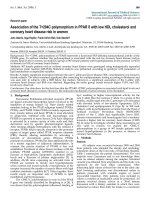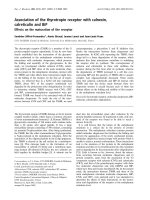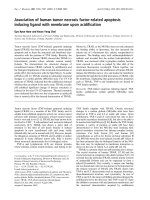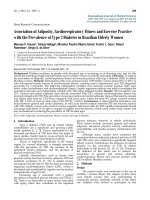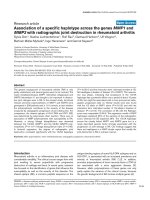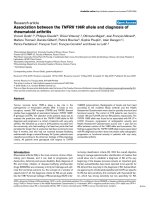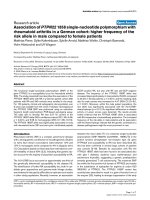Báo cáo y học: "Association of the T allele of an intronic single nucleotide polymorphism in the colony stimulating factor 1 receptor with Crohn''''s disease: a case-control study" ppt
Bạn đang xem bản rút gọn của tài liệu. Xem và tải ngay bản đầy đủ của tài liệu tại đây (594.81 KB, 8 trang )
BioMed Central
Page 1 of 8
(page number not for citation purposes)
Journal of Immune Based Therapies
and Vaccines
Open Access
Original research
Association of the T allele of an intronic single nucleotide
polymorphism in the colony stimulating factor 1 receptor with
Crohn's disease: a case-control study
Adriana Zapata-Velandia
1,4
, San-San Ng
2,4
, Rebecca F Brennan
1
,
Neal R Simonsen
5
, Mariella Gastanaduy
1,4
, Jovanny Zabaleta
3,4
,
Jennifer J Lentz
2
, Randall D Craver
3
, Hernan Correa
3
, Alberto Delgado
3
,
Angela L Pitts
2,4
, Jane R Himel
1,4
, John N Udall Jr
1
, Eberhard Schmidt-
Sommerfeld
1
, Raynorda F Brown
1
, Grace B Athas
3
, Bronya B Keats
4
and
Elizabeth E Mannick*
1,4
Address:
1
Louisiana State University Department of Pediatrics, New Orleans, LA 70112, USA,
2
Louisiana State University Department of Genetics,
New Orleans, LA 70112, USA,
3
Louisiana State University Department of Pathology, New Orleans, LA 70112, USA,
4
Stanley S. Scott Cancer Center,
New Orleans, LA 70112, USA and
5
Louisiana State University School of Public Health, New Orleans, LA, 70112 USA
Email: Adriana Zapata-Velandia - ; San-San Ng - ; Rebecca F Brennan - ;
Neal R Simonsen - ; Mariella Gastanaduy - ; Jovanny Zabaleta - ;
Jennifer J Lentz - ; Randall D Craver - ; Hernan Correa - ;
Alberto Delgado - ; Angela L Pitts - ; Jane R Himel - ;
John N Udall - ; Eberhard Schmidt-Sommerfeld - ; Raynorda F Brown - ;
Grace B Athas - ; Bronya B Keats - ; Elizabeth E Mannick* -
* Corresponding author
Abstract
Background: Polymorphisms in several genes (NOD2, MDR1, SLC22A4) have been associated with susceptibility to Crohn's
disease. Identification of the remaining Crohn's susceptibility genes is essential for the development of disease-specific targets
for immunotherapy. Using gene expression analysis, we identified a differentially expressed gene on 5q33, the colony stimulating
factor 1 receptor (CSF1R) gene, and hypothesized that it is a Crohn's susceptibility gene. The CSF1R gene is involved in
monocyte to macrophage differentiation and in innate immunity.
Methods: Patients provided informed consent prior to entry into the study as approved by the Institutional Review Board at
LSU Health Sciences Center. We performed forward and reverse sequencing of genomic DNA from 111 unrelated patients with
Crohn's disease and 108 controls. We also stained paraffin-embedded, ileal and colonic tissue sections from patients with
Crohn's disease and controls with a polyclonal antibody raised against the human CSF1R protein.
Results: A single nucleotide polymorphism (A2033T) near a Runx1 binding site in the eleventh intron of the colony stimulating
factor 1 receptor was identified. The T allele of this single nucleotide polymorphism occurred in 27% of patients with Crohn's
disease but in only 13% of controls (X
2
= 6.74, p < 0.01, odds ratio (O.R.) = 2.49, 1.23 < O.R. < 5.01). Using
immunohistochemistry, positive staining with a polyclonal antibody to CSF1R was observed in the superficial epithelium of ileal
and colonic tissue sections.
Conclusions: We conclude that the colony stimulating factor receptor 1 gene may be a susceptibility gene for Crohn's disease.
Published: 14 May 2004
Journal of Immune Based Therapies and Vaccines 2004, 2:6
Received: 20 April 2004
Accepted: 14 May 2004
This article is available from: />© 2004 Zapata-Velandia et al; licensee BioMed Central Ltd. This is an Open Access article: verbatim copying and redistribution of this article are permitted
in all media for any purpose, provided this notice is preserved along with the article's original URL.
Journal of Immune Based Therapies and Vaccines 2004, 2 />Page 2 of 8
(page number not for citation purposes)
Introduction
Crohn's disease is a chronic intestinal disorder of
unknown etiology characterized by weight loss, abdomi-
nal pain, diarrhea, arthritis and the development of fistu-
lae and abscesses. It causes significant morbidity and
affects approximately 1 in 1000 individuals in the devel-
oped world. Crohn's disease is believed to ensue from the
action of an environmental trigger(s) including alteration
in host intestinal flora on a genetically susceptible host
mucosal immune system and intestinal epithelial barrier
[1]. A variety of Crohn's disease susceptibility loci have
been identified by genetic mapping studies. The first
Crohn's disease susceptibility gene, NOD2, was identified
definitively in 2002 by positional cloning and linkage dis-
equilibrium mapping as well as candidate gene
approaches [2,3]. NOD2 encodes an intracellular receptor
for muramyl dipeptide, a component of the peptidogly-
can moiety of bacterial cell walls, and triggers a cascade of
signaling events resulting in the activation of NF-kappa B
and the host innate immune system [4]. NOD2 is
expressed in monocytes and in intestinal epithelial cells,
including Paneth cells [5]. Crohn's disease-associated
mutations in NOD2 result in defective NF kappa B activa-
tion, suggesting that Crohn's disease may represent, in
part, a defect in innate immunity [4].
A second gene that has recently been linked to Crohn's
disease and ulcerative colitis susceptibility is the multid-
rug resistance transporter 1 (MDR1). A single nucleotide
polymorphism (SNP) in the coding region of the gene
(Ala893Ser/Thr) has been found to occur more frequently
in patients with Crohn's disease and a second SNP
(C3435T) has been associated with ulcerative colitis sus-
ceptibility [6,7]. The MDR1 gene encodes an ATP-binding
cassette (ABC) family member that pumps neutral and
cationic hydrophobic molecules out of the cell and plays
a role in resistance to chemotherapy. Intriguingly, MDR1-
/- mice develop spontaneous colitis in the presence of nor-
mal intestinal bacteria [8]. The MDR1 protein may also
play a role in host defense against intracellular bacteria by
extruding them from the cell, explaining its protective role
in intestinal inflammation, but this hypothesis remains to
be proven [8].
Identification of additional Crohn's disease susceptibility
genes is important to complete the puzzle of Crohn's dis-
ease pathogenesis and to develop specific, targeted immu-
notherapies. A region of broad susceptibility to
inflammatory bowel disease has been identified on chro-
mosome 5q31-5q33 and is known as IBD5 [9]. Within
this region, a Crohn's disease susceptibility haplotype
comprising a cytokine cluster on 5q31 has been identified
[10]. Interestingly, a missense substitution in SLC22A4, a
gene in this region that is a downstream target of the tran-
scription factor, Runx1, is associated with susceptibility to
Crohn's disease [11]. Moreover, an intronic SNP in a
Runx1 binding site of SLC22A4 has been found in rheu-
matoid arthritis, an autoimmune disease that sometime
occurs in individuals and families affected by Crohn's dis-
ease [12]. Polymorphisms in the promoter of the CD14
gene, which plays a critical role in lipopolysaccharide sig-
naling and is located downstream from the cytokine clus-
ter, have been linked to Crohn's disease susceptibility in a
case-control study [13].
To our knowledge, no Crohn's disease-related polymor-
phisms in genes located in the 5q32 or 5q33 region have
been reported. Using microarray analysis to examine gene
expression in endoscopic colonic biopsies from patients
with newly diagnosed, untreated Crohn's disease, we
identified an overexpressed gene on 5q33, CSF1R (unpub-
lished data). We hypothesized that this gene was a candi-
date gene for Crohn's disease susceptibility. The CSF1R is
a tyrosine kinase receptor proto-oncogene involved in
monocyte to macrophage differentiation [14]. Although
expression of CSF1R has been detected in epithelial cells
of other organs, the expression of CSF1R in the intestine
has not been well documented [15-18]. Here we report
the results of a case-control study of Louisiana patients
with Crohn's disease and ethnically similar controls
showing increased prevalence of the T allele of a SNP
(A2033T)* near an intronic Runx1 binding site in the
CSF1R gene in patients with Crohn's disease. We also
show, using immunohistochemistry, that the CSF1R pro-
tein is expressed in the superficial epithelium of the ileum
and colon.
*This SNP occurs 2033 base pairs from the 3' end of the
eleventh exon of the CSF1R gene.
Methods
Patients
Patients (n = 111) and controls (n = 108) were recruited
in the study from Children's Hospital of New Orleans and
private practices in Southeastern Louisiana and Western
Mississippi after Louisiana Health Sciences Center Institu-
tional Review Board (IRB) approval and informed con-
sent and assent. Patient and control DNA were also
obtained from archival colonic tissue blocks after IRB
approval.
DNA extraction and purification
Genomic DNA was obtained from one of 3 sources for all
subjects: peripheral blood buffy coat, buccal swab or par-
affin-embedded archival tissue blocks. For blood, ten ml
of whole blood was collected in purple top, EDTA tubes
and buffy coats prepared using red blood cell lysis buffer
(NH
4
Cl, NH
4
HCO
3
, H
2
O), pellet buffer (1 M Trix HCl pH
8.0, 0.5 M EDTA, NaCl, H
2
O), 10% SDS and Proteinase K.
Buffy coats were heated in a water bath overnight at 56°C
Journal of Immune Based Therapies and Vaccines 2004, 2 />Page 3 of 8
(page number not for citation purposes)
and stored at -20°C. DNA was extracted using phe-
nol:chloroform:isoamyl alcohol, followed by chloroform,
and precipitated in 100% ethanol. After air drying, the
pellet was resuspended in TE buffer and its quantity and
integrity were verified by 1% agarose gel and spectropho-
tometry (Beckman Coulter, DU640B).
DNA was extracted from buccal swabs (Epicentre Technol-
ogies, Madison, Wisconsin) following the manufacturer's
instructions. Briefly, swabs were placed in DNA extraction
solution, mixed for ten seconds and incubated at 60°C for
30 min, then a total of 16 min at 98°C. After centrifuga-
tion at 10,000 × g at 4°C, the supernatant was transferred
to a clean tube and stored at -20°C.
For archival tissue blocks, 3 sections of 10 µm were cut
and incubated twice with 1 ml of n-octane (Sigma, St.
Louis, MO) at 56°C for 15 min. After centrifugation at
10,000 × g at room temperature (RT), the pellet was resus-
pended in 1 ml 100% EtOH and then in 1 ml 75% EtOH.
After the last centrifugation, the pellet was resuspended in
85 µl of pellet buffer (10 mM Tris-HCL, ph 8.0, 10 mM
EDTA, pH 8.0, 150 mM NaCl) followed by 5 µl of Protei-
nase K (20 mg/ml) (Invitrogen, Grand Island, NY) and 10
µl 10% SDS (Invitrogen). The samples were incubated
overnight at 56°C. One hundred µl of phenol chloro-
form:iso-amylalcohol (50:1) (Sigma) was added and the
sample was centrifuged at 10,000 × g for 5 min at RT. The
aqueous phase was transferred to a clean tube and 100 ul
of chloroform were added (Sigma). The sample was cen-
trifuged at 10,000 × g for 5 min and the aqueous phase
transferred to a clean tube and mixed with 200 µl 100%
ethanol (Aldrich) and incubated at -70°C for at least 1 hr.
The DNA was precipitated by centrifugation and resus-
pended in TE buffer. The DNA concentration was deter-
mined by UV spectrophotometry.
PCR
Forward and reverse primers to amplify DNA in the vicin-
ity of the SNP of interest were designed using the Primer
Quest
SM
(Integrated DNA Technologies (IDT), Coralville,
IA) program and ordered from IDT. The primer sequences
are: (F) 5'TTC TCT GAG CAG CTC CAA TG3' and (R)
3'CCA CAG ACA GGC CAC TTC TT5'.
Master Mix for PCR was prepared using Taq polymerase,
dNTPs and other reagents from Invitrogen (Carlsbad,
CA). After optimization of conditions, PCR reactions were
carried out in a Bio-Rad I-cycler. The PCR product was
resolved on a 1% agarose gel and purified using Qiaquick
DNA Purification Kit (Qiagen, Valencia, CA).
DNA Sequencing
Forward and reverse DNA sequencing to detect the
A2033T SNP in intron 11 of the CSF1R gene was per-
formed in the LSU Sequencing Core. Briefly, in a 0.2 mL
PCR tube, DNA template, primer, BigDye Terminator
Ready Reaction Mix (PE Applied Biosystems, Foster City,
CA), 5X sequencing mix, and HPLC water were combined
to 20 µl.
Tubes were placed in a thermal cycler (GeneAmp PCR
9700) set to the following program.
30 cycles 96°C – 10 seconds
58°C – 5 seconds
60°C – 4 minutes
Extension products were purified by adding 3 M NaOAc,
pH 4.6 and 95% EtOH to reaction tubes for 20 m and
spinning tubes upright at 3600 rpm for 30 m. Tubes were
then inverted and spun at 700 rpm for 1 m. After washing
the pellet in 70% EtOH, tubes were spun at 3600 for 10
m. The procedure beginning with inversion of tubes was
repeated, tubes centrifuged at 700 rpm for 1 m and air
dried. To analyze the sequencing reaction, formamide was
added to each tube and denatured for 3 m at 95°C, fol-
lowed by wet ice. The sequencing gel was prepared using
urea, HPLC water, Long Ranger 50% (PE Applied Biosys-
tems) and 10X TBE buffer, stirring for 1 h. 10% APS and
TEMED were added to the filtered gel solutions and gel
was loaded into a cassette with glass plates in an ABI 3100
automated sequencer equipped with ABI PRISM Data Col-
lection Software. 1X TBE was used as running buffer for
gel electrophoresis. Fluorescent dye labels were used to
incorporate into DNA extension products. Four different
dyes were used to identify the A, C, G, and T extension
reactions using an argon laser.
Immunohistochemistry
Table 1: Crohn's Disease Status vs CSF1R A2033T SNP: All Patients
CD- CD+ Total
T Allele Absent 94 (87%) 81 (73%) 175
T Allele Present 14 (13%) 30 (27%) 44
Total 108 111 219
χ
2
= 6.74 (p < 0.01) O.R.:2.49 (1.23 < O.R. < 5.01)
Journal of Immune Based Therapies and Vaccines 2004, 2 />Page 4 of 8
(page number not for citation purposes)
Slides cut from paraffin-embedded tissue blocks were
deparaffinized, hydrated, and blocked with 3% hydrogen
peroxide at RT for 15 min. After rinsing in distilled water,
they were placed in PBS for 2 min and then blocked with
Biocare's Background Sniper (Biocare Medical, Walnut
Creek, CA) for 10 min at RT. Slides were incubated with
primary antibody (rabbit polyclonal antibody to human
c-fms, Cymbus Biotechnology, Ltd., Chandlers Ford,
Hants, UK) at a dilution of 1:100 for 60 min at RT and,
after rinsing with PBS, incubated with secondary antibody
(MACH 2 Rabbit-HRP Polymer, Biocare Medical) for 30
min at RT. After rinsing with PBS, slides were placed in
diaminobenzamide for 7 min at RT, rinsed in 2 changes of
distilled water, counterstained with hematoxylin, dehy-
drated and mounted with resinous medium.
Data analysis
Numbers of patients with the T allele of the A2033T SNP
were compared to numbers of controls using a chi-square
statistic. An odds ratio with 95% confidence interval was
calculated using SAS software (SAS, Cary, NC).
Table 2: A2033T SNP Allele by Ethnicity
CROHN'S PATIENTS T Allele Absent T Allele Present Total
Acadian 10 (53%) 9 (47%) 19
African-American 17 (85%) 3 (15%) 20
Caucasian 44 (75%) 15 (25%) 59
Hispanic 2 (100%) 0 (0%) 2
Jewish 4 (80%) 1 (20%) 5
Unknown 4 (67%) 2 (23%) 6
Total 81 30 111
CONTROL PATIENTS T Allele Absent T Allele Present Total
Acadian 36 (84%) 7 (16%) 43
African-American 4 (57%) 3 (43%) 7
Caucasian 32 (91%) 3 (9%) 35
Hispanic 7 (87%) 1 (13%) 8
Jewish 3 (100%) 0 (0%) 3
Unknown 12 (100%) 0 (0%) 12
Total 94 14 108
Table 3: Ethnicity vs CSF1R A2003T SNP: Crohn's Patients
Acadian Non-Acadian Total
T Allele Absent 10 (53%) 71 (77%) 81
T Allele Present 9 (47%) 21 (23%) 30
Total 19 92 111
χ
2
= 4.81 (p < 0.05) O.R.:3.04 (1.09 < O.R. < 8.47)
Table 4: Crohn's Disease Status vs CSF1R A2033T SNP: Non-Acadian Patients
CD- CD+ Total
T Allele Absent 58 (89%) 71 (77%) 129
T Allele Present 7 (11%) 21 (23%) 28
Total 65 92 157
Fisher exact test (p = 0.025) O.R.:2.45 (0.97 < O.R. < 6.17)
Journal of Immune Based Therapies and Vaccines 2004, 2 />Page 5 of 8
(page number not for citation purposes)
Results
Association of the T allele of the A2033T SNP with Crohn's
disease especially in patients of Acadian descent
A SNP (A2033T) was detected in the eleventh intron of the
CSF1R gene that was located 77 base pairs downstream
from a Runx1 binding site (TGTGGT). Forward and
reverse sequencing of this SNP was performed in 111
patients with Crohn's disease and 108 controls (Table 1).
Thirty patients with Crohn's disease (27%) but only four-
teen controls (13%) had the T allele of the SNP (χ
2
= 6.74,
p < 0.01, O.R. = 2.49 with 95% confidence interval, 1.23
< O.R. < 5.01). Data from the stratification of Crohn's
patients and control patients by ethnicity (Table 2) sug-
gest that the differential expression of the SNP was more
pronounced in some ethnic groups (Acadian) than in oth-
ers (African American). In the case of Crohn's patients of
Acadian descent, the rate of the T allele (47% vs. 23%) was
significantly higher than the rate of the T allele in all other
ethnicities combined (Table 3; χ
2
= 4.01, p < 0.05, O.R. =
3.04 with 95% confidence interval, 1.09 < O.R. < 8.47).
Since there were more controls of Acadian descent than
patients of Acadian descent (Table 2), it is unlikely that
the higher rate of the T allele of the A2033T SNP noted in
Crohn's patients in general (Table 1) can be attributed to
ethnicity. However, to exclude the possibility that Acadian
ethnicity was a confounding variable, we compared rates
of the T allele in non-Acadian patients with Crohn's dis-
ease to those of non-Acadian controls (Table 4). In this
analysis, patients with Crohn's disease still had signifi-
cantly higher rates of the T allele than controls.
The CSF1R protein is expressed in the superficial
epithelium of the ileum and colon
Paraffin-embedded, formalin-fixed tissue sections from
control patients were stained with a rabbit anti-human
polyclonal antibody to CSF1R and read by a pathologist.
Negative controls were stained with secondary antibody
alone. Positive cytoplasmic staining was noted in the
superficial epithelium of the ileum and colon with differ-
entiated cells being sloughed off into intestinal lumen
staining most vividly (Figure 1A,1B,1C). Examination of
the intracellular staining pattern revealed a characteristic
staining pattern with the terminal web and the lateral
junctions of intestinal epithelial cells (Figure 1A).
Discussion
Based on gene expression data, chromosomal location
and biological function, we have evidence that the colony
stimulating factor 1 receptor gene may contribute to
Crohn's disease susceptibility. Using a case-control study,
we have shown that a SNP in an intron of this gene is asso-
ciated with Crohn's disease. Whether this SNP is in close
proximity to another disease-causing SNP in the same (or
a neighboring) gene or is itself disruptive of gene func-
tioning in a way that increases susceptibility to Crohn's
disease will be the focus of future studies.
The CSF1R gene is an intriguing candidate gene for
Crohn's disease susceptibility for several reasons. First, it
is involved in innate immunity and host defense against
fungi and certain bacteria such as Listeria that have been
postulated to play a role in Crohn's disease pathogenesis
[19,20]. Second, CSF1R is involved in an intracellular sig-
nal transduction cascade linking the G alpha i2 receptor to
the transcription factor Stat3. In NIH3T3 cells expressing
a dominant negative G alpha i2, Stat3 phosphorylation by
v-fms (oncogenic CSF1R) was inhibited [21]. This is
significant because targeted disruption of either the G
alpha i2 gene or the Stat3 transcription factor (in mono-
cytes) results in inflammatory bowel disease in rodents
[22,23]. These data suggest that a signaling pathway
involving G alpha i2, Stat3 and CSF1R is critical for pro-
tection against intestinal inflammation. One possible
mechanism is the regulation of IL-10, a cytokine known to
be essential for normal intestinal homeostasis [24]. Third,
acute myelogenous leukemia and myelodysplasia, two
conditions that may occur with increased frequency in the
context of Crohn's disease, are associated with polymor-
phisms or deletions in the CSF1R gene [25-27].
There is a paucity of literature regarding the expression of
the CSF1R protein in the intestine despite documentation
of its presence in the epithelium of a variety of other tis-
sues including breast, ovary, endometrium, lung and
prostate [15-18,28]. Therefore, we examined its expres-
sion by immunostaining and found it to be expressed in
the cytoplasm of certain epithelial cells of the superficial
epithelium and villous tips of the ileum and colon,
including cells that were being sloughed into the lumen.
Because of this superficial location of staining, it is tempt-
ing to hypothesize that the CSF1R protein plays a role in
differentiation of intestinal epithelial cells as it does in
macrophages. The most intense cytoplasmic staining
occurred in the terminal web of the epithelial cell and in
the lateral junctions of the cells. The localization of CSF1R
in actin-rich areas of the cell is not surprising in view of
data from in vitro studies demonstrating that the CSF1R
protein mediates morphological changes in macrophages
through the regulation of paxillin and focal adhesions
[29]. What role the CSF1R protein might play in cytoskel-
etal regulation in either mononuclear cells or in intestinal
epithelial cells the intestine as well as its expression pat-
tern and pathogenic role in inflammatory bowel disease
remain to be investigated further.
Studies of the prevalence of NOD2 polymorphisms in
patients with Crohn's disease point to a subset of patients
with ileal and fibrostenotic disease who are more likely to
have the NOD2 genotype [30]. Moreover, specific NOD2
Journal of Immune Based Therapies and Vaccines 2004, 2 />Page 6 of 8
(page number not for citation purposes)
polymorphisms are more prevalent in some ethnic groups
[31,32]. The numbers of patients enrolled in the current
study do not permit conclusive analysis of disease subtype
or ethnicity. However, we did find that patients of Aca-
dian descent (descendants of émigrés from French Can-
ada) have a higher prevalence of the disease-associated
SNP in CSF1R. This is interesting because the population
in which the IBD5 susceptibility locus was originally iden-
tified was, in part, French Canadian [9].
We do not know what the significance, if any, is of the
location of the A2033T SNP near a binding site for the
transcription factor, RUNX1. It is intriguing to note, how-
ever, that SNPs in RUNX1 binding sites and in the RUNX1
gene itself have been associated with a variety of autoim-
mune conditions, including psoriasis, systemic lupus ery-
thematosus, type I diabetes mellitus and rheumatoid
arthritis [11,33-35]. Since the CSF1R gene is a target of
RUNX1 and has multiple RUNX1 binding sites in several
introns [35], complete sequencing of each of these sites
will be performed to investigate the hypothesis that defec-
tive RUNX1 binding is related to Crohn's disease suscep-
tibility [36].
Sections from paraffin-embedded tissue blocks of normal human ileum and colon were stained with polyclonal rabbit anti-human antisera to CSF1R and a horseradish peroxidase-conjugated goat anti-rabbit secondary antibody with diaminobenza-mide used as chromagenFigure 1
Sections from paraffin-embedded tissue blocks of normal human ileum and colon were stained with polyclonal rabbit anti-
human antisera to CSF1R and a horseradish peroxidase-conjugated goat anti-rabbit secondary antibody with diaminobenza-
mide used as chromagen. A. Superficial epithelium of the terminal ileum with cytoplasmic staining of the terminal web and lat-
eral junctions of the epithelial cells (green arrow). B. Staining of the superficial epithelium of the colon. C. Staining of the
superficial epithelium of the ileum with an epithelial cell being sloughed off into the lumen (green arrow). 100×.
A.
B. C.
Journal of Immune Based Therapies and Vaccines 2004, 2 />Page 7 of 8
(page number not for citation purposes)
Conclusions
In a case-control study of Louisiana patients with Crohn's
disease, we have detected a SNP (A2033T) in the eleventh
intron of the CSF1R gene that is significantly associated
with the disease. We propose that the CSF1R gene is a can-
didate gene for Crohn's disease.
Competing interests
None declared.
Authors' contributions
AZV performed the molecular genetic studies and assisted
in the recruitment of patients, the data analysis and the
drafting of the paper. SSN performed the sequencing. RB
recruited patients and ensured compliance with the IRB.
NS performed the statistical analyses. MG assisted in data
collection, entry and sequence alignment. JZ assisted with
primer design and optimization. JL recruited patients and
entered data. RC furnished archival tissue blocks. HC read
and photographed stained slides. AD performed immu-
nohistochemistry. AP performed sequencing. J.H.
recruited patients. JU referred patients. ESS referred
patients. RB referred patients. GA recruited patients and
reviewed the manuscript. BK provided technical advice
and assistance related to study design and analysis. EM
conceived of the study, recruited patients, performed the
data analysis and drafted the manuscript.
Acknowledgments
This work was sponsored in part by grants from the Louisiana Board of
Regents, the Toler Foundation, the Louisiana Digestive Health Foundation
and the Solomon family to E.M.
References
1. Pallone F, Blanco Gdel V, Vavassori P, Monteleone I, Fina D, Mon-
teleone G: Genetic and pathogenetic insights into inflamma-
tory bowel disease. Curr Gastroenterol Rep 2003, 5:487-92.
2. Ogura Y, Bonen DK, Inohara N, Nicolae DL, Chen FF, Ramos R, Brit-
ton H, Moran T, Karalluskas R, Duerr RH, Achkar JP, Brant SR, Bay-
less TM, Kirschner BS, Hanauer SB, Nunez G, Cho JH: A frameshift
mutation in NOD2 associated with susceptibility to Crohn's
disease. Nature 2001, 411:603-606.
3. Hugot JP, Chamaillard M, Zouali H, Lesage S, Cezard JP, Belaiche J,
Almer S, Tysk C, O'Moraln CA, Gassull M, Binder V, Finkel Y, Cortot
A, Modigliani R, Laurent-Puig P, Gower-Rousseau C, Macry J,
Colombel JF, Sahbalou M, Thomas G: Association of NOD2 leu-
cine-rich repeat variants with susceptibility to Crohn's
disease. Nature 2001, 411:599-603.
4. Inohara N, Ogura Y, Fontalba A, Guttierrez O, Pons F, Crespo J,
Fukase K, Inamura S, Kusumoto S, Hashimoto M, Foster SJ, Moran AP,
Fernandez-Luna JL, Nunez G: Host recognition of bacterial
muramyl dipeptide mediated through NOD2. Implications
for Crohn's disease. J Biol Chem 2003, 278:5509-12.
5. Ogura Y, Lala S, Xin W, Smith E, Dowds TA, Chen FF, Zimmermann
E, Tretiakova M, Cho JH, Hart J, Greenson JK, Keshav S, Nunez G:
Expression of NOD2 in Paneth cells: a possible link to
Crohn's ileitis. Gut 2003, 52:591-7.
6. Brant SR, Panhuysen CI, Nicolae D, Reddy DM, Bonen DK, Karaliukas
R, Zhang L, Swanson E, Datta LW, Moran T, Ravenhill G, Duerr RH,
Achkar JP, Karban AS, Cho JH: MDR1 Ala893 polymorphism is
associated with inflammatory bowel disease. Am J Hum Genet
2003, 73:1282-92.
7. Schwab M, Schaeffeler E, Marx C, Fromm MF, Kaskas B, Metzler J,
Stange E, Herfarth H, Schoelmerich J, Gregor M, Walker S, Cascorbi
I, Roots I, Brinkmann U, Zanger UM, Eichelbaum M: Association
between the C3435T MDR1 gene polymorphism and suscep-
tibility for ulcerative colitis. Gastroenterology 2003, 124:26-33.
8. Panwala CM, Jones JC, Viney JL: A novel model of inflammatory
bowel disease: mice deficient fro the multiple drug resist-
ance gene, mdr1a, spontaneously develop colitis. J Immunol
1998, 161:5733-5744.
9. Rioux JD, Silverberg MS, Daly MJ, Steinhart AH, McLeod RS, Griffiths
AM, Green T, Brettin TS, Stone V, Bull SB, Bitton A, Williams CN,
Greenberg GR, Cohen Z, Lander ES, Hudson TJ, Siminovitch KA:
Genomewide search in Canadian families with inflammatory
bowel disease reveals two novel susceptibility loci. Am J Hum
Genet 2000, 66:1863-70.
10. Rioux JD, Daly MJ, Silverberg MS, Lindblad K, Steinhart H, Cohen Z,
Delmonte T, Kocher K, Miller K, Guschwan S, Kulbokas EJ, O'Leary
S, Winchester E, Dewar K, Green T, Stone V, Chow C, Cohen A,
Longelier D, Lapointe G, Gaudet D, Faith J, Branco N, Bull SB,
McLeod RS, Griffiths AM, Bitton A, Greenberg GR, Lander ES, Simi-
novitch KA, Hudson TJ: Genetic variation in the 5q31 cytokine
gene cluster confers susceptibility to Crohn disease. Nat Genet
2001, 29:223-8.
11. Peltekova VD, Wintle RF, Rubin LA, Amos CI, Huang Q, Gu X, New-
man B, Van Oene M, Cescon D, Greenberg G, Griffiths AM, St
George-Hyslop PH, Siminovitch KA: Functional variants of
OCTN cation transporter genes are associated with Crohn
disease. Nat Genet 2004, 36:471-5.
12. Tokuhiro S, Yamada R, Chang X, Suzuki A, Kochi Y, Sawada T, Suzuki
M, Nagasaki M, Ohtsuki M, Ono M, Furukawa H, Nagashima M,
Yoshino S, Mabuchi A, Sekine A, Saito S, Takahashi A, Tsunoda T,
Nakamura Y, Yamamoto K: An intronic SNP in a RUNX1 bind-
ing site of SLC22A4, encoding an organic cation transporter,
is associated with rheumatoid arthritis. Nat Genet 2003,
35:341-8.
13. Klein W, Tromm A, Griga T, Fricke H, Folwaczny C, Hocke M, Eitner
K, Marx M, Duerig N, Epplen JT: A polymorphism in the CD14
gene is associated with Crohn disease. Scand J Gastroenterol
2002, 37:189-91.
14. Riccioni R, Saulle E, Militi S, Sposi NM, Gualtiero M, Mauro N, Mancini
M, Diverio D, Lo Coco F, Peschle C, Testa U: C-fms expression
correlates with monocytic differentiation in PML-RAR
alpha+ acute promyelocytic leukemia. Leukemia 2003,
17:98-113.
15. Sapi E, Flick MB, Rodov S, Carter D, Kacinski BM: Expression of
CSF-1 and CSF-1 receptor by normal lactating mammary
epithelial cells. J Soc Gynecol Investig 1998, 5:94-101.
16. Buaknecht T, Kiechle-Schwarz M, du Bois A, Wolfle J, Kacinski B:
Expression of transcripts for CSF-1 and for the "macro-
phage" and "epithelial" isoforms of the CSF-1R transcripts in
human ovarian carcinomas. Cancer Detect Prev 1994, 18:231-9.
17. Smith HO, Anderson PS, Kuo DY, Goldberg GL, DeVictoria CL,
Boocock CA, Jones JG, Runowicz CD, Stanley ER, Pollard JW: The
role of colony-stimulating factor 1 and its receptor in the eti-
opathogenesis of endometrial adenocarcinoma. Clin Cancer
Res 1995, 1:313-25.
18. Ide H, Seligson DB, Memarzadeh S, Xin L, Horvath S, Dubey P, Flick
MB, Kacinski BM, Palotie A, Witte ON: Expression of colony-
stimulating factor 1 receptor during prostate development
and prostate cancer progression. Proc Natl Acad Sci U S A 2002,
99:14404-9.
19. Nemunaitis J, Shannon-Dorcy K, Appelbaum FR, Meyers J, Owens A,
Day R, Ando D, O'Neill C, Buckner D, Singer J: Long-term follow-
up of patients with invasive fungal disease who received
adjunctive therapy with recombinant human macrophage
colony-stimulating factor. Blood 1993, 82:1422-7.
20. Jin Y, Dons L, Kristensson K, Rottenberg ME: Colony-stimulating
factor 1-dependent cells protect against systemic infection
with Listeria monocytogenes but facilitate neuroinvasion.
Infect Immun 2002, 70:4682-6.
21. Corre I, Baumann H, Hermouet S: Regulation by G
i2
proteins of
v-fms-induced proliferation and transformation via Src-
kinase and STAT3. Oncogene 1999, 18:6335-6342.
22. Rudolph U, Finegold MJ, Rich SS, Harriman GR, Srinivasan Y, Brabet
P, Boulay G, Bradley A, Birnbaumer L: Ulcerative colitis and ade-
nocarcinoma of the colon in G alpha i2-deficient mice. Nat
Genet 1995, 10:143-50.
Publish with BioMed Central and every
scientist can read your work free of charge
"BioMed Central will be the most significant development for
disseminating the results of biomedical research in our lifetime."
Sir Paul Nurse, Cancer Research UK
Your research papers will be:
available free of charge to the entire biomedical community
peer reviewed and published immediately upon acceptance
cited in PubMed and archived on PubMed Central
yours — you keep the copyright
Submit your manuscript here:
/>BioMedcentral
Journal of Immune Based Therapies and Vaccines 2004, 2 />Page 8 of 8
(page number not for citation purposes)
23. Welte T, Zhang SS, Wang T, Zhang Z, Hesslein DG, Yin Z, Kano A,
Iwamoto Y, Li E, Craft JE, Bothwell AL, Fikrig E, Koni PA, Flavell RA,
Fu XY: STAT3 deletion during hematopoiesis causes Crohn's
disease-like pathogenesis and lethality: a critical role of
STAT3 in innate immunity. Proc Natl Acad Sci U S A 2003,
100:1879-84.
24. Takeda K, Clausen BE, Kaisho T, Tsujimura T, Terada N, Forster I,
Akira S: Enhanced Th1 activity and development of chronic
enterocolitis in mice devoid of Stat3 in macrophages and
neutrophils. Immunity 1999, 10:39-49.
25. Ridge SA, Worwood M, Oscier D, Jacobs A, Padua RA: FMS muta-
tions in myelodysplastic, leukemic, and normal subjects. Proc
Natl Acad Sci U S A 1990, 87:1377-1380.
26. Dombret H, Marolleau JP: De novo acute myeloid leukemia in
patients with Crohn's disease. Nouv Rev Fr Hematol 1995,
37:193-6.
27. Harewood GC, Loftus EV Jr, Tefferi A, Tremaine WJ, Sandborn WJ:
Concurrent inflammatory bowel disease and myelodysplas-
tic syndromes. Inflamm Bowel Dis 1999, 5:98-103.
28. Heisterkamp N, Groffen J, Stephenson JR: Isolation of v-fms and
its human cellular homolog. Virology 1983, 126:248-58.
29. Pixley FJ, Lee PSW, Condeelis JS, Stanley ER: Protein tyrosine
phosphatase φ regulates paxillin tyrosine phosphorylation
and mediates colony stimulating factor 1-induced morpho-
logical changes in macrophages. Mol Cell Biol 2001,
21:1795-1809.
30. Lesage S, Zouali H, Cezard JP, Colombel JF, Belaiche J, Almer S, Tysk
C, O'Morain C, Gassull M, Binder V, Finkel Y, Modigliani R, Gower-
Rousseau C, Macry J, Merlin F, Chamaillard M, Jannot AS, Thomas G,
Hugot JP, EPWG-IBD Group, EPIMAD Group, GETAID Group:
CARD15/NOD2 mutational analysis and genotype-pheno-
type correlation in 612 patients with inflammatory bowel
disease. Am J Hum Genet 2002, 70:845-57.
31. Sugimura K, Taylor KD, Lin YC, Hang T, Wang D, Tang YM, Fischel-
Ghodsian N, Targan SR, Rotter JI, Yang H: A novel NOD2/
CARD15 haplotype conferring risk for Crohn disease in
Ashkenazi Jews. Am J Human Genet 2003, 72:509-18.
32. Croucher PJ, Mascheretti S, Hampe J, Huse K, Frenzel H, Stoll M, Lu
T, Nikolaus S, Yang SK, Krawczak M, Kim WH, Schreiber S: Haplo-
type structure and association to Crohn's diseas of CARD15
mutations in two ethnically divergent populations. Eur J Hum
Genet 2003, 11:6-16.
33. Nielsen C, Hansen D, Husby S, Jacobsen BB, Lellevang ST: Associa-
tion of a putative regulatory polymorphism in the PD-1 gene
with susceptibility to type 1 diabetes. Tissue Antigens 2003,
62:492-7.
34. Helms C, Cao L, Krueger JG, Wijsman EM, Chamian F, Gordon D,
Heffernan M, Daw JA, Robarge J, Ott J, Kwok PY, Menter A, Bowcock
AM: A putative RUNX1 binding site variant between
SLC9A3R1 and NAT9 is associated with susceptibility to
psoriasis. Nat Genet 2003, 35:349-56.
35. Prokunina L, Castillejo-Lopez C, Oberg F, Gunnarsson I, Berg L, Mag-
nusson V, Broookes AJ, Tentler D, Kristiansdottir H, Grondal G, Bol-
stad AI, Svenungsson E, Lundberg I, Sturfelt G, Jonssen A, Truedsson
L, Lima G, Alcocer-Varela J, Johsson R, Gyllensten UB, Harley JB, Alar-
con-Segovia D, Steinsson K, Alarcon-Riquelme ME: A regulatory
polymorphism in PDCD1 is associated with susceptibility to
systemic lupus erythematosus in humans. Nat Genet 2002,
32:666-9.
36. Fears S, Gavin M, Zhang DE, Hetherington C, Ben-David Y, Rowley
JD, Nucifora G: Functional characterization of ETV6 and
ETV6/CBFA2 in the regulation of the MCSFR proximal
promoter. Proc Natl Acad Sci USA 1997, 94:1949-1954.
